Now that almost every business has an online presence, getting online reviews is a normal part of everyday life.
Still, it can be challenging to know the best way to respond to customer feedback. And with automotive reputation, unfortunately, being historically mediocre, you'll likely run into a few difficult customers when you have increased review quantity.
There’s always a temptation to deny damaging accusations, contradict the review, or just ignore the review. Unfortunately, this can make you look less-than-admirable when responding.
Responding to online reviews is an opportunity your dealership shouldn’t waste. Many car-buying advice sites actively tell consumers to look at dealership online reviews. It can help you build your online reputation, attract shoppers, and reassure your clientele that you care about them. Keep in mind, more than the person who left the review will be reading your response!
With the advent of the Google Business Profile and Google reviews, and review sites like Yelp, car dealers cannot afford to not manage reviews.
Visibility is too high, and more customers than ever are taking to the internet to voice their experiences and monitor/check on the reputation of those they might do business with. Getting ahead of your online reputation management has never been more important!
Avoid the biggest missteps by not allowing inexperienced employees to handle reviews on your social accounts or website. Having response templates for each review type will empower your social team to manage online reviews properly, showcase your proactive approach to potential customers, and avoid harming your online reputation and customer experience.
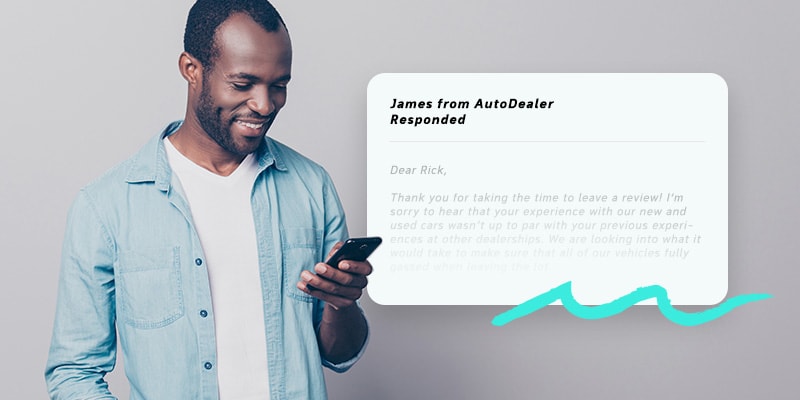
Only Responding to Positive Reviews is a Bad Look
If you don’t address feedback, you miss the opportunity to soften negative reviews or enhance the visibility of positive reviews. Timing matters, too: 85% of consumers think reviews more than 3 months old are irrelevant, and 40% only care about reviews that are 2 weeks old or less.
The person who wrote the review wants an even timelier response: 52% of consumers expect a business to respond to their review in 7 days or less — especially if it was a negative one.
First, let's take a look at general reputation management principles with how to respond and carry yourself in review management, whether it's negative or positive. These go for any type of reputation management, but remember to apply them to your own work in the automotive industry/automotive business.

Tips For Responding To Negative Reviews (And Positive Reviews, Too)
Negative reviews aren’t fun. They can bruise the ego and act as a red flag to other potential customers. It’s understandable to feel upset or flustered over a bad review, but don’t let that reflect on your review response.
The last thing you want to do is compound the situation with unprofessionalism or play the blame game — that is, a signed, sealed, and delivered death sentence. On the other hand, you definitely don’t want to take a negative review lying down.
The following are best practices you can follow as a car dealer who is faced with a negative review:
- Be personal.
Now is not the time for generic, hollow follow-up (on second thought, there really is no time for that).
Show your customer you’re listening, and address them directly. In other words: treat them like a real person with real feelings.
Most of your reviews will be through some service platform like Google, so there is no excuse not to address each customer by name.
- Show gratitude.
Regardless of the nature of the review: always thank the customer for taking the time to leave feedback, bringing something to your organization’s attention, etc.
Being gracious also gives some humanity to the response. And anything that helps you distance yourself from suspicion of being an automated response is welcomed here. Good review management requires a gracious but concise tone.
- Apologize and display empathy.
Apologize. Sincerely! Avoid apologies that imply the customer is irrationally upset. That customer felt slighted: so own up to it. If you abide by the “the customer is always right” principle, this should be easy.
“We apologize that your experience was not the best it could be. We strive for high customer satisfaction but clearly fell short here.”
This is an excellent example of owning an apology and highlighting that your intention is genuine.
- Hold yourself accountable and take responsibility.
These virtues go along with the previous point, but they deserve their own mention. Accountability is key. Humans make up our organizations, and humans aren’t perfect. As such, organizations and their processes are imperfect as well.
Admit to making a mistake, even if you feel you’ve done nothing wrong. That customer’s experience — their perception — is valid and should be treated as such. Potential customers don't care about you winning the debate. How customers feel matters, and they will take the customer's side in the matter.
Own the situation, apologize, and provide reassurance. You can help the automotive business' preconceived notions by leading the charge here.
- The best apology is changed behavior.
Communicate changes you will implement and offer to make things right (if possible). Be detailed in recounting the customer’s concerns back to them, and highlight solutions where you can.
How you handle and follow up on negative reviews highlights your willingness to have a dynamic conversation about the situation and do better next time. Other customers can, and will, take note of this.
- Take it outside of the reviews.
This might be the most crucial part in putting your best foot forward in the face of a negative review: Talk directly with the customer. Offer a direct line for the customer to follow up with you to discuss matters further.
The advantage to this is two-fold: one, you get right on the customer’s level and make yourself available as a resource. And two, you take their activities offline to prevent any further visibility while you mend your side of things.
Automotive Reputation Management is a Science
Now that you've seen some tips on general automotive reputation management principles, it's time to look deeper into possible templates to help frame these principles.
Reputation management should NOT be a cut-and-paste afterthought, but it can help provide a good skeleton on formatting and general sentiment.
5 Reliable Review Templates to Help Online Reputation
There are times to mirror the tone of your customer review, such as when they’ve written a humorous review, or positive reviews where they have a bright attitude. At other times, you’ll want to soften an overly gushing tone to bring a sense of realistic expectations back to the review section.
When you receive bad reviews, they need a specific and delicate touch. Having templates to match different review types will help your social media person (or team) create effective, consistent responses to every kind of review.

The Gusher
This kind of reviewer just can’t stop raving. They may use superlative phrases like best, most amazing, or finest. While it’s great to see a positive review, you have to rein in your customer expectations just a bit. If you let rave reviews build up insane expectations unchallenged, you run the risk of future customers looking for a level of customer experience you can’t realistically deliver.
Example:
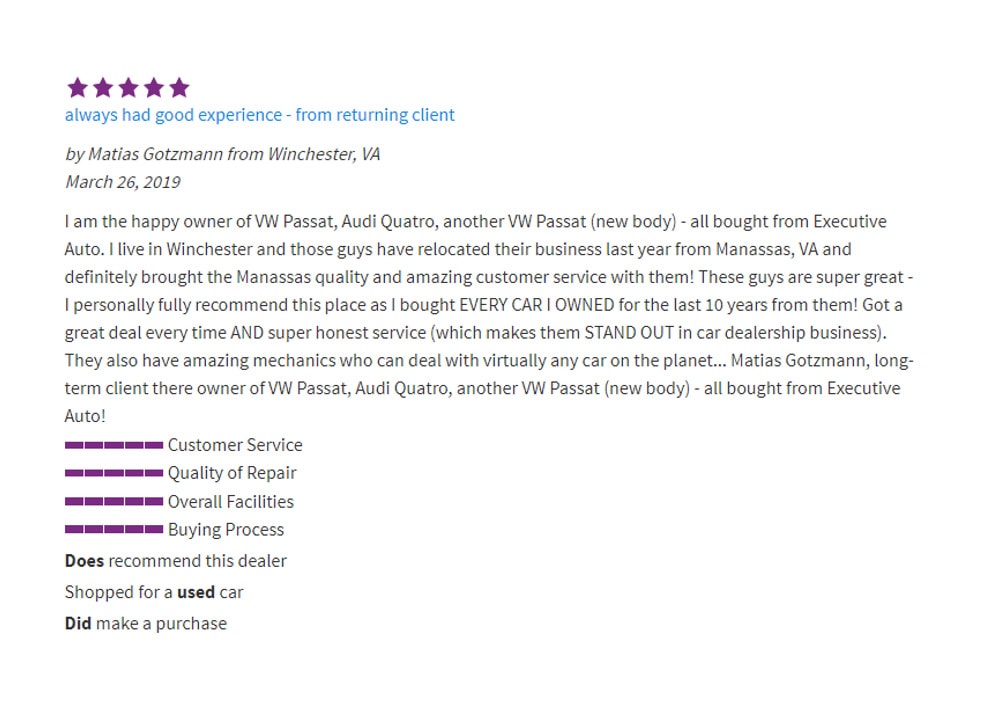
Here’s a format you can use to respond:
Dear [name],
Thank you for taking the time to leave a review! I’m so glad to hear that you thoroughly enjoyed your vehicle-buying and service experiences at our dealership.
Since you’re one of our best customers, we always look forward to seeing you. Come back anytime to receive the same great service we give to all of our customers!
[Manager name or initials] [date]
This response subtly hints that you didn’t go above and beyond only for this customer, and their high praise is partially a matter of perspective. It also denotes that you try to help everyone feel this satisfied when they leave your dealership.
Below, a dealership nails the perfect short-and-sweet response to a thrilled customer:
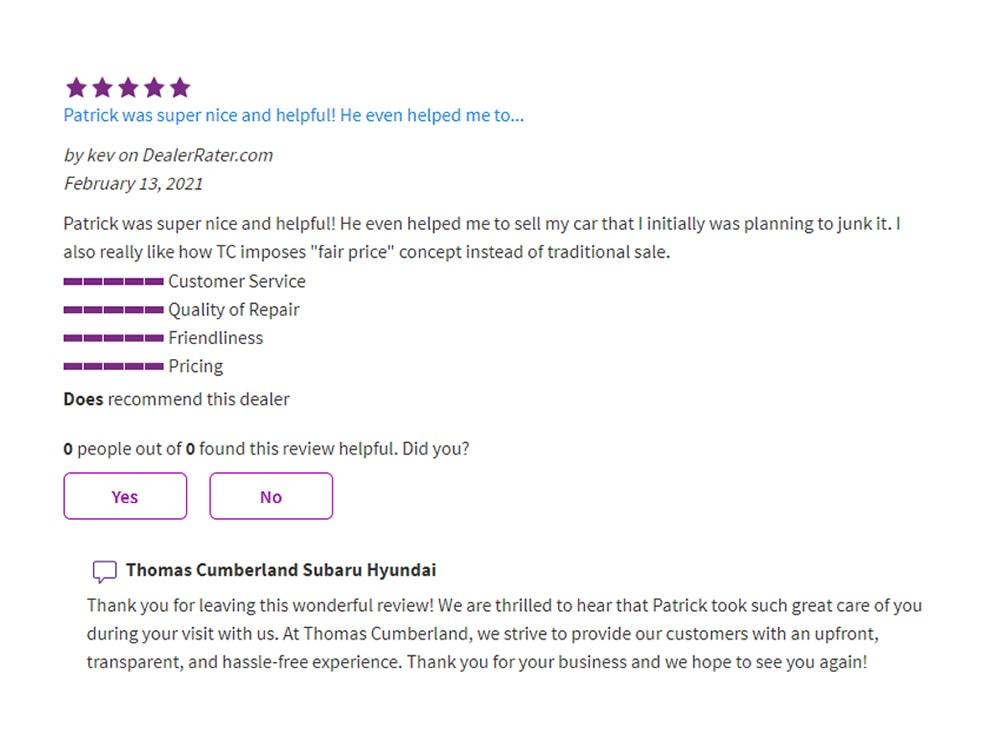

The Nit-Picker
This kind of customer has overall nice things to say but makes sure to throw in a few negative elements. Maybe you didn’t have their desired vehicle color in stock, or you ran out of creamer for the free coffee. Don’t be alarmed, because this is the perfect opportunity to display your commitment to customer service and a great customer experience.
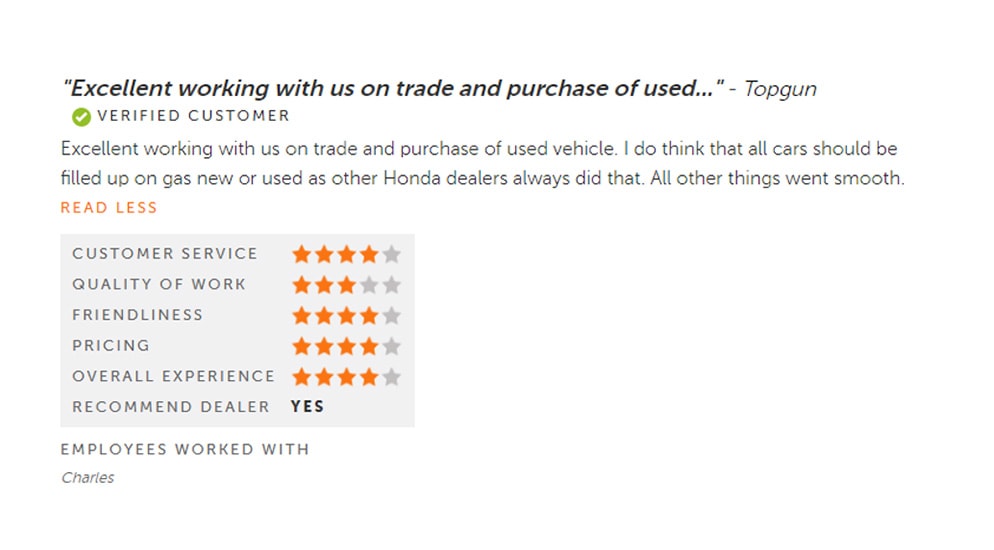
A great response would be:
Dear [name],
Thank you for taking the time to leave a review! I’m sorry to hear that your experience with our new and used cars wasn’t up to par with your previous experiences at other dealerships. We are looking into what it would take to make sure that all of our vehicles fully gassed when leaving the lot.
We value your patronage, and we want all of our customers to be more than satisfied with the service we offer. We hope to serve you again.
[Manager name or initials] [date]
This kind of response acknowledges the problem, thanks the reviewer (instead of blaming them) for making you aware of the issue, and promises to resolve the problem with specificity. This kind of proactive response reassures not only the reviewer but also prospective customers, that you take concerns seriously and are willing to address them with real action.

The Sorta-Annoyed
This reviewer may have been having a bad day. Even if you met their needs promptly, external factors may have added to their frustrations and colored their experience. They are venting their annoyance, and they want you to know about it.
The worst thing you can do is blame the customer. If something happened that you can point to as a truly temporary problem (perhaps your site was loading slowly due to server issues), then you can mention that, and say that it’s now resolved. Otherwise, don’t make excuses for the problem; only offer solutions and reasons why it isn’t likely to happen again.
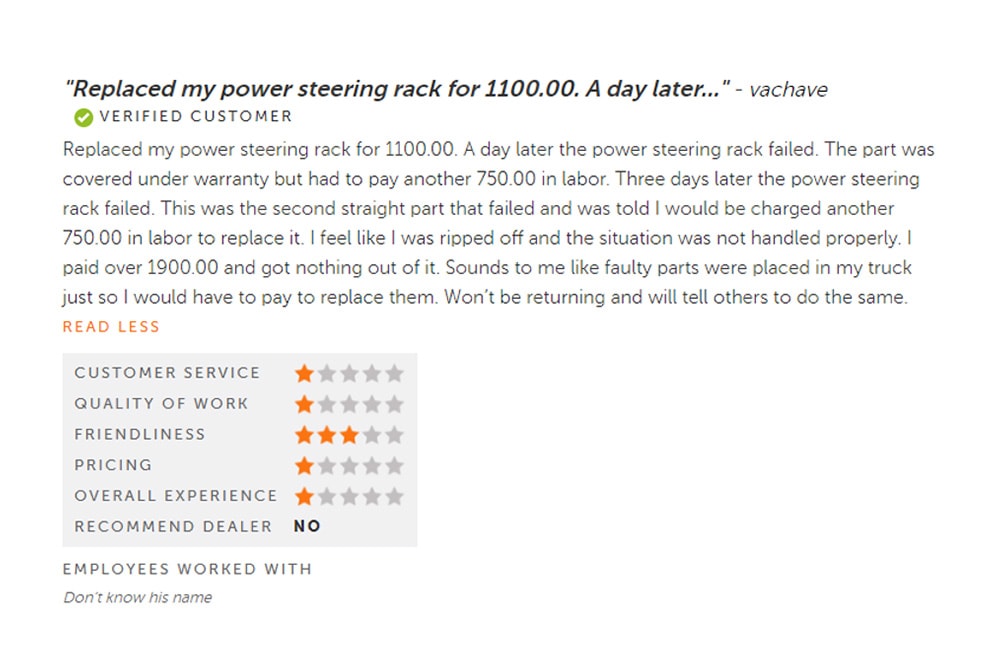
The dealer’s response was pretty generic, and didn’t address the specific problems in the review:
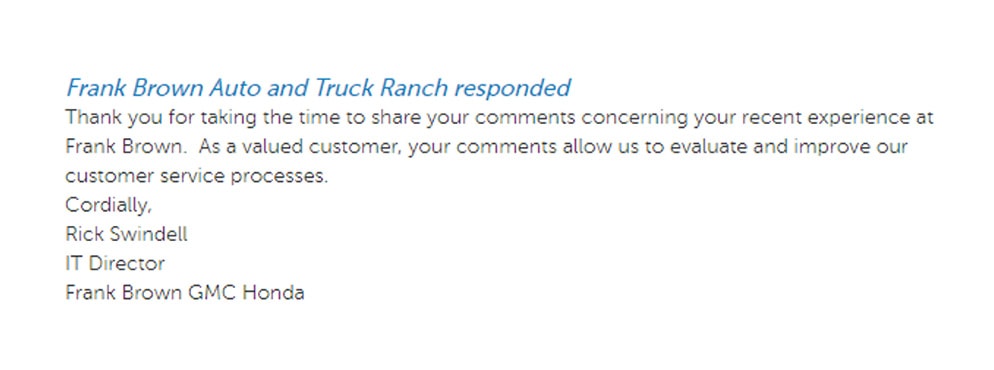
A better response might have been:
Dear [name],
Thank you for taking the time to leave a review! I’m so sorry to hear that your experience with your power steering replacement was so dissatisfactory. We have taken another look at our part suppliers to see if we can increase the consistency and quality of our parts. Since the parts were faulty, let me see what I can do about discounting the labor for installation. That sounds very frustrating for you, and I’d like to make it right.
We value your patronage, and we want all of our customers to enjoy their time with us. We hope you’ll give us another chance, and we look forward to serving you in the future.
[Manager name or initials] [date]
As always, meet the problems head-on and show that you’re addressing their concerns. This may (hopefully) result in your reviewer editing their rating, but at the very least, you will impress future customers with your willingness to take responsibility.

The Slice-and-Dice
This quasi-professional reviewer has refined tastes and a large vocabulary. They like making their options known, and doing it in a way that impresses people. They’re likely to use strong language and state things as facts that are probably a matter of opinion.
This is one review type to be very careful with. You can’t promise to fix unfixable problems (such as the free showroom wi-fi being slightly too slow) or change the “too-glaring” colors on your website.
They might even rake your sales employees over the coals despite everyone behaving admirably. If this is the case, don’t throw anyone to the wolves. You could offer to make sure someone else assists them in the future, gently implying that there was just a mismatch of personalities on the last occasion. You can very subtly frame the customer as hard-to-please, but never call them out as such.
We can’t know if the events here are objectively told, but it’s definitely a zinger:
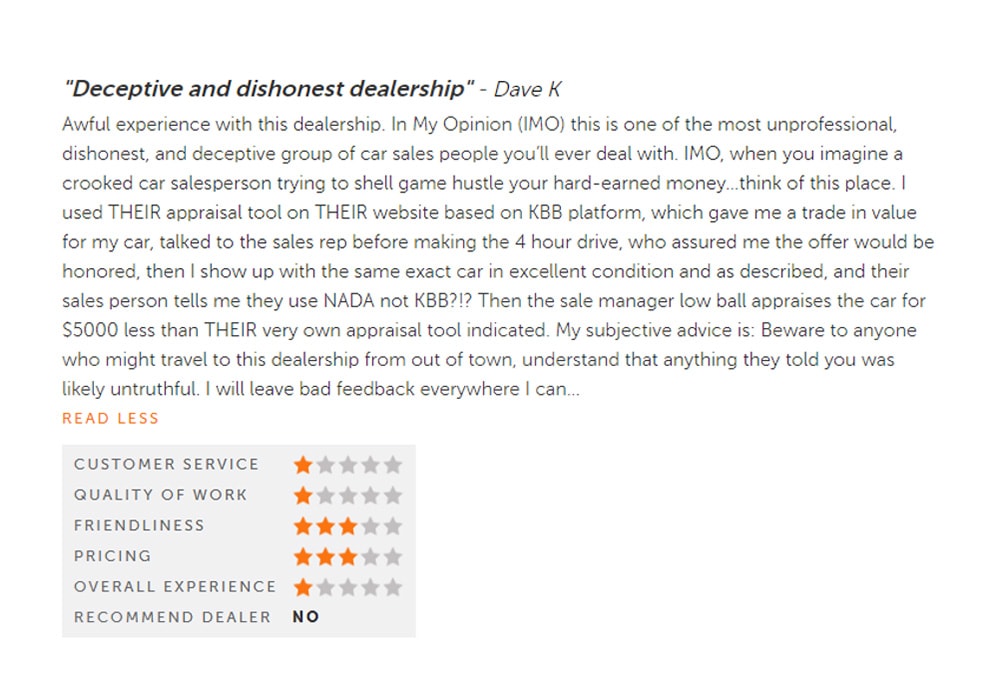
A good response might look like this:
Dear Dave,
Thank you for taking time out of your day to review our dealership. We are very sorry to hear that your experience with our used car appraisal process did not meet your expectations. We do everything we can to serve our customers and gain their satisfaction. Our goal is to make sure every customer has a great car-buying experience with us!
Please be assured that we’ve taken your words into account, and are working on making sure our website appraisal better matches the in-person one going forward. Next time you visit us, the manager will personally assist you to ensure that there are no problems.
We value your patronage, and we want all of our customers to enjoy their time with us. We hope you’ll give us another chance, and we look forward to serving you in the future.
[Manager name or initials] [date]
Tread carefully with this kind of customer, because they might demand special treatment that falls outside of what you can reasonably deliver. If your response fails to satisfy them, you can also ask them to reach out to a manager for a direct chat, and offer a discount or bonus toward a future vehicle purchase or service visit. By offering compensation for their poor experience, there’s a chance they will amend their review to something more positive.

The Never-Good-Enough
If you receive an angry rant from someone who simply can’t be pleased, or accuses you of things that didn’t quite happen, it’s tempting to ignore it. It’s also tempting to reply with a detailed explanation of exactly how they are incorrect.
Resist the urge to do either one of those things.
If the blows against you are truly unwarranted, it should be obvious to readers without you pointing it out. If it’s not obvious, you can hint slightly, but never directly butt heads with the reviewer.
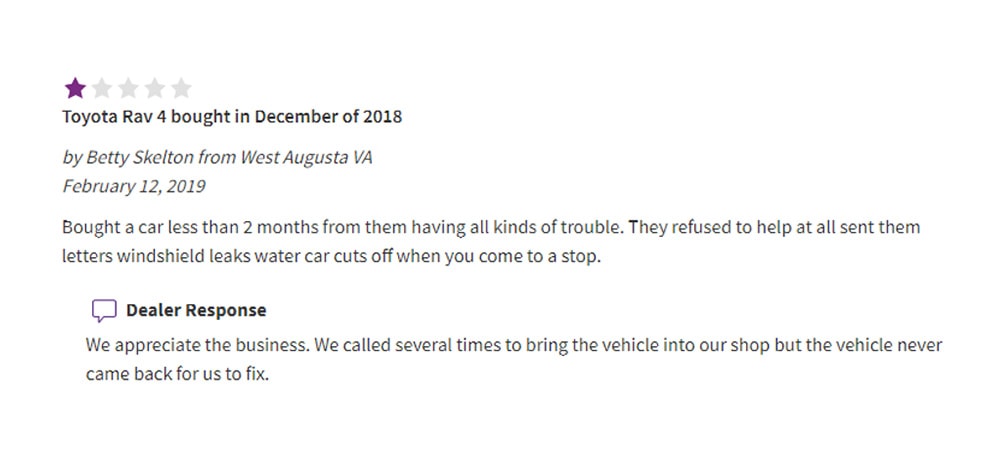
The dealer in question did a mediocre job responding. They say they tried to help and avoided directly accusing the customer, but basically said, “we can’t fix what you don’t bring us.”
This isn’t the worst possible response, but could definitely have been better:
Dear Betty,
Thank you for taking time out of your day to review your experience with the vehicle you purchased from us. We are sorry to hear that you didn’t receive the level of service you expected. We reached out to you several times to set up an appointment, but something must have gone wrong, and we weren’t able to connect.
Perhaps there was a mistake when we took down your contact info. We’re going to double-check that from now on to make sure this never happens again. Please reach out to us and we’ll try to address your issues.
We value all of our customers and are saddened if someone leaves our dealership less than pleased with us. Hopefully, we can do better and gain your approval the next time you stop by.
[Manager name or initials] [date]
With this kind of response, you are taking the customer seriously, not going on the defensive, and still promising to serve this customer to the highest standards in the future. If the reviewer is really laying it on thick, you don’t have to roll over and plead guilty, just like this dealer didn’t.
Still, being overly defensive gives credence to the bad review, and this response teases that line just a little.
Don't Ignore Online Reputation Management and Automotive Reputation Management

Hopefully, you don’t get many 1-star reviews, but when you do, handling it with tact and confidence will show your customers that you really care about their concerns.
Dealing with reviews can be challenging, but it’s an under-utilized way to show your customers your commitment to serving them.
ActivEngage's Engagement Solutions Can Help Boost Your Online Reputation
The engagement solutions offered by ActivEngage can help your dealership provide the highest quality customer experience, leading to a better online reputation. Check these out!
- Live guidance through the digital retailing process with RetailSync
- Video test drives and vehicle overviews with MyDrive
- Tailored, behavioral offers with ActivTarget








